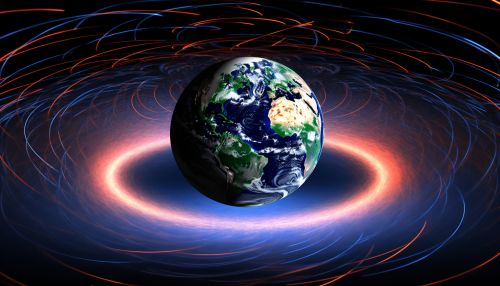Earth's Magnetic Field
Introduction
The Earth's magnetic field is a complex and dynamic force that plays a crucial role in our planet's geology, climate, and habitability. It is generated by the convective motion of molten iron within the Earth's outer core, a process known as the geodynamo. This magnetic field extends from the Earth's interior out into space, where it interacts with the solar wind, a stream of charged particles emanating from the sun.


Generation of the Earth's Magnetic Field
The Earth's magnetic field is primarily generated in the outer core by a self-sustaining dynamo process. The outer core, composed of liquid iron and nickel, moves in a convective motion due to heat escaping from the planet's interior. This convective motion, combined with the rotation of the Earth, drives the geodynamo that generates the magnetic field.
The Geodynamo
The geodynamo is the mechanism that generates the Earth's magnetic field. The convective motion of the outer core, driven by heat from the inner core and the mantle, combined with the rotation of the Earth, generates electrical currents. These electrical currents create a magnetic field, which is then amplified by the motion of the conductive fluid.


Magnetic Field Reversals
The Earth's magnetic field has not always pointed north. Instead, it has undergone numerous reversals, where the north and south magnetic poles switch places. These geomagnetic reversals occur irregularly, with an average interval of several hundred thousand years. The last reversal, known as the Brunhes-Matuyama reversal, occurred approximately 780,000 years ago.
Structure of the Earth's Magnetic Field
The Earth's magnetic field is often visualized as a giant bar magnet embedded in the Earth, with magnetic field lines extending from the south pole to the north pole. However, this is a simplification. The actual magnetic field is more complex, with field lines that are not perfectly symmetrical.
Main Field
The main field is the part of the Earth's magnetic field that originates from the core. It accounts for about 95% of the field strength at the Earth's surface. The main field is mostly dipolar, meaning it has two poles, north and south, similar to a bar magnet.
External Field
The external field is the part of the Earth's magnetic field that originates from interactions with the solar wind and the magnetosphere. This field is highly variable, changing with solar activity and the Earth's position relative to the sun.


Effects of the Earth's Magnetic Field
The Earth's magnetic field has numerous effects, both on the Earth itself and on the life that inhabits it. It protects the Earth from solar wind, helps maintain our atmosphere, and plays a role in animal navigation.
Protection from Solar Wind
The Earth's magnetic field plays a crucial role in protecting the planet from the solar wind. Without it, the solar wind would strip away the Earth's atmosphere, making life as we know it impossible.
Many animals, including birds, sea turtles, and bees, use the Earth's magnetic field for navigation. This ability, known as magnetoreception, allows these animals to navigate over long distances, even when other landmarks are not visible.


Conclusion
The Earth's magnetic field is a complex and vital aspect of our planet. Generated by the geodynamo in the Earth's outer core, it extends out into space, protecting the Earth from solar wind and playing a crucial role in animal navigation. Despite its importance, many aspects of the Earth's magnetic field remain poorly understood, and it continues to be a subject of ongoing scientific research.
